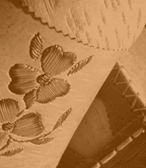There are two main techniques for making stone tools. Both are based on the
reduction of rough stone. The first is known as chipping or flaking. Flaked
stone tools are made by repeatedly striking the raw material with another stone
(or antler), and systematically removing flakes along a carefully planned path.
It is this orderly pattern on chipped stone tools that allows archaeologists
to distinguish items made by humans from natural stone. This action reduces
and refines the original piece as each flake is removed, until the desired tool
begins to take shape. Larger, less intricate tools such as hide scrapers were
made this way.
Pecking, grinding and polishing (the second major technique) were used to shape
more complex stone objects, such as arrowheads or stone pipes. Small stone-headed
hammers or grinding stones might be used in this process.
These manufacturing techniques could be used alone or in combination, depending
on the type of stone object being made.

